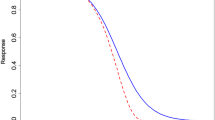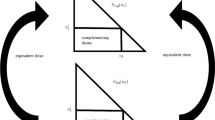Abstract
Although graphic surfaces have been used routinely in the study of combined action of agents, they are mainly used for display purposes. In this paper, it is shown that useful mechanistic information can be obtained from an analytical study of these surfaces using the tools of differential geometry. From the analysis of some simple dose-effect surfaces, it is proposed that the intrinsic curvature, referred to in differential geometry as the Gaussian curvature, of a dose-effect surface can be used as a general criterion for the classification of interaction between different agents. This is analogous to the interpretation of the line curvature of a dose-effect curve as an indication of self-interaction between doses for an agent. In this framework, the dose-effect surface would have basic uniform fabric with zero curvature in the absence of interaction, tentatively referred to as null-interaction. Pictorially speaking, this fabric is distorted locally or globally like the stretching and shrinking of a rubber sheet by the presence of interaction mechanisms between different agents. Since self-interaction with dilution dummies does not generate intrinsic curvature, this criterion of null-interaction would describe the interaction between two trulydifferent agents. It is shown that many of the published interaction mechanisms give rise to dose-effect surfaces with characteristic curvatures. This possible correlation between the intrinsic geometric curvature of dose-effect surfaces and the biophysical mechanism of interaction presents an interesting philosophical viewpoint for the study of combined action of agents.
Similar content being viewed by others
Literature
Ashford, J. R. 1981. General models for the joint action of mixtures of drugs.Biometrics 37, 457–474.
Berenbaum, M. C. 1985. The expected effect of a combination of agents: the general solution.J. theor. Biol. 114, 413–431.
Box, G. E. P. 1954. The exploration and exploitation of response surfaces. Some general considerations and examples.Biometrics 10, 16–60.
Carter, Jr, W. H., C. Gennings, J. G. Staniswalis, E. D. Campbell and K. L. White Jr., 1988. A statistical approach to the construction and analysis of isobolograms.J. Am. coll. Toxicol. 7, 963–973.
Chou, T. C. and P. Talalay. 1984. Quantitative analysis of dose-effect relationships: The combined effects of multiple drugs or enzyme inhibitors.Adv. Enzyme Regul. 22, 27–55.
Chou, T. C. and P. Talalay. 1987. Applications of the median-effect principle for the assessment of low-dose risk of carcinogens and for the quantitation of synergism and antagonism of chemotherapeutic agents. InNew Avenues in Developmental Cancer Chemotherapy, K. R. Harrap and T. A. Connors (Eds), pp. 37–64. Orlando: Academic Press.
Dewey, W. C. 1979.In vitro systems: standardization of endpoints.Int. J. Radiat. Oncol. Biol. Phys. 5, 1165–1174.
Gessner, P. K. 1988. A straightforward method for the study of drug interactions. An isobolographic analysis primer.J. Am. coll. Toxicol. 7, 987–1012.
ICRU. International Commission on Radiation Units and Measurements. 1979.Quantitative Concepts and Dosimetry in Radiobiology. ICRU Report No. 30. Bethesda, MD: ICRU.
Krogstad, D. J. and R. C. Moellering. 1980. Combinations of antibiotics, mechanisms of interaction against bacteria. InAntibiotics in Laboratory Medicine, V. Lorian (Ed.), pp. 298–341. Baltimore: Williams and Wilkins.
Lam, G. K. Y. 1988. The combined effects of mixtures of ionizing radiations.J. theor. Biol. 134, 531–546.
Lam, G. K. Y. 1989. Analysis of interaction for mixtures of agents using the linear isobole.Bull. math. Biol. 51, 293–309.
Lam, G. K. Y. 1990. On the biophysical interpretation of the mathematical product of dose and relative biological effectiveness.Phys. med. Biol. 35, 481–488.
Lipschutz, M. M. 1969.Theory and Problems of Differential Geometry. New York: McGraw-Hill.
Loewe, S. 1953. The problem of synergism and antagonism of combined drugs.Arzneim-Forsch.3, 285–290.
Steel, G. G. 1979. Terminology in the description of drug-radiation interactions.Int. J. Radiat. Oncol. Biol. Phys. 5, 1145–1150.
Stoker, J. J. 1989.Differential Geometry. New York: Wiley-Interscience.
Tyrrell, R. M. 1978. Radiation synergism and antagonism.Photochem. Photobiol. Rev. 3, 35–113.
UNSCEAR. United Nations Scientific Committee on the Effects of Atomic Radiation, 1982. InIonizing Radiation: Sources and Biological Effects. New York: United Nations Publications.
Weatherburn, C. E. 1964.Differential Geometry of Three Dimensions, London: English Language Book Society and Cambridge University Press.
Author information
Authors and Affiliations
Rights and permissions
About this article
Cite this article
Lam, G.K.Y. The study of combined action of agents using differential geometry of dose-effect surfaces. Bltn Mathcal Biology 54, 813–826 (1992). https://doi.org/10.1007/BF02459931
Received:
Revised:
Issue Date:
DOI: https://doi.org/10.1007/BF02459931




